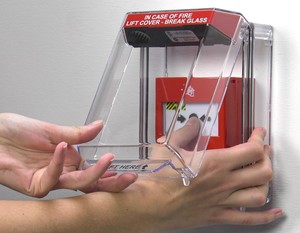

|
Brian Sims
Editor |
| Home> | Fire | >Alarms and Detection | >False fire alarm numbers continue to rise in post-pandemic period |
| Home> | Fire | >Fire and Rescue | >False fire alarm numbers continue to rise in post-pandemic period |
False fire alarm numbers continue to rise in post-pandemic period
11 April 2023
FALSE FIRE alarm numbers continue to rise in the post-pandemic period, in turn causing major issues for the economy. The latest Home Office figures for the year ending September 2022 reveal that Fire and Rescue Services attended 238,885 false fire alarm activations. That’s the largest total of false fire alarms recorded in over a decade and an increase of 10% when compared with the previous year.

With an 18% increase from the previous year for malicious false fire alarms, 6,473 false alarms were determined. The number is still rising in the post-COVID period.
At 38%, false fire alarms continue to be the largest proportion of incidents attended by the Fire and Rescue Service. On that basis, it’s increasingly important to minimise false alarms in order to ensure both the safety of individuals and the efficient use of the Emergency Services.
BS 5839:2017-1 recommends that: “All Manual Call Points should be fitted with a protective cover, which is moved to gain access to the frangible element” in order to reduce false alarms. This recommendation is essential in helping to ensure that buildings are adequately protected against the risk of false fire alarms.
Protective covers can also act as a deterrent to malicious activations of Call Points. A teenager was arrested in Aberdeen after setting off fire alarms more than a dozen times, which a police investigation determined to be a ‘deliberate and malicious’ act. Firefighters attended calls and wasted time and resources, meaning that they could not respond to real emergency calls.
Costly and disruptive
False fire alarms are costly – to the tune of around £1 billion per annum in the UK – and also disruptive. They often require emergency responders to mobilise and respond to a non-existent emergency, thereby wasting time and resources.
False fire alarms can also be costly for building owners with fines introduced for repeated false alarms to the Emergency Services. The latter may have to attend multiple times, draining resources that could be better used elsewhere.
They can also cause panic and confusion, particularly so if they occur frequently, making it harder for people to take the necessary steps to evacuate safely in the event of a real fire. Frequent false alarms can lead to complacency among building occupants, who may not take real fire alarms seriously, potentially putting themselves and others at risk.
Protective covers can help to control the number of accidental and malicious false fire alarms. False alarms can also be reduced by regularly checking and testing equipment to ensure that it’s not faulty.
Strong and durable
As a business, Safety Technology International manufactures tough covers that have been specifically designed to help deter false fire alarms and to prevent the malicious or accidental activation of Manual Call Points. The strong and durable construction of the company’s Stopper polycarbonate Call Point protectors means that they can withstand the toughest of knocks, while in parallel offering lasting protection against false fire alarms.
With various models available in a range of sizes and colours, and multi-language or custom text options, Safety Technology International can realise covers suitable for most applications or devices. Sounder models help to deter malicious activations thanks to an audible alarm that draws immediate attention to the area. Waterproof models take care of external applications.
*Further information is available online at www.sti-emea.com
- Alarm fatigue in the UAE
- Prevent false fire alarms & deter theft
- False fire alarms still a big issue
- False fire alarms continue to cost UK plc £1 billion-plus per annum
- New series of Sirens and Strobes
- Standard procedure
- STI to launch product catalogue
- STI leads fight against false alarms
- Intersec 2020 the best yet for STI
- Raising the bar












